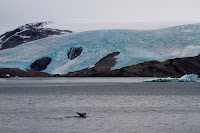Was it due to Steffen’s special birthday that we were
granted with yet another splendid day here in Greenland?! Everything started
with a spectacular sunrise and soon after the Fram entered the picturesque
Prins Christian Sund, a 60 km long channel in the very south of the country. High mountain peaks, glaciers and waterfalls make up a breathtaking landscape
and not one cloud was seen in the perfectly blue sky.
 Anja had called Aappilattoq, a little village in the middle
of the Sund, only 30 hours ago and asked if they would be prepared to receive a
visit from our ship. Fortunately, they were indeed very happy and we could make
an extra landing here as special bonus. And a special landing this was indeed!
We received a very warm welcome from the inhabitants (particularly the
children!), many of them in their national costumes. Boys and men wear a white
anorak, black trousers and the traditional “kamiks”, the boots made of animal
skin. The female dresses are much more colourful with their carefully handmade
pearl collars.
Anja had called Aappilattoq, a little village in the middle
of the Sund, only 30 hours ago and asked if they would be prepared to receive a
visit from our ship. Fortunately, they were indeed very happy and we could make
an extra landing here as special bonus. And a special landing this was indeed!
We received a very warm welcome from the inhabitants (particularly the
children!), many of them in their national costumes. Boys and men wear a white
anorak, black trousers and the traditional “kamiks”, the boots made of animal
skin. The female dresses are much more colourful with their carefully handmade
pearl collars.
Lots of pictures were taken – but not only from us! Also the
locals enthusiastically could not stop making photos of each other.
When everybody was ashore, we were invited to assist an
open-air dance performance ending with passengers, staff and locals all dancing
together in a round circle.
We further had the opportunity for a ‘kaffeemik’ in the
school (which is quite impressive, given that they currently only have 22
pupils), to visit the church, to wander around in the settlement or to climb a
little hill for a better view.
Finally, the local choir came on board - in addition to the
school children who were happily exploring the ship and trying out the table
tennis. We all gathered in the Observation Lounge to listen to some songs and
to watch another polka performance.
In summary, our visit was a highly enjoyable intercultural
encounter and very much appreciated by everybody involved.
 The voyage then continued through the reminder of the Prins
Christian Sund and took us later in the afternoon to Ikigait. Facing the steep
cliffs of an impressive mountain, remains of an old Viking settlement are still
visible. It is easy to imagine them living here during sunshine weather like
today – but how had life been during long winter nights and endless snow
storms?
The voyage then continued through the reminder of the Prins
Christian Sund and took us later in the afternoon to Ikigait. Facing the steep
cliffs of an impressive mountain, remains of an old Viking settlement are still
visible. It is easy to imagine them living here during sunshine weather like
today – but how had life been during long winter nights and endless snow
storms? 
















































